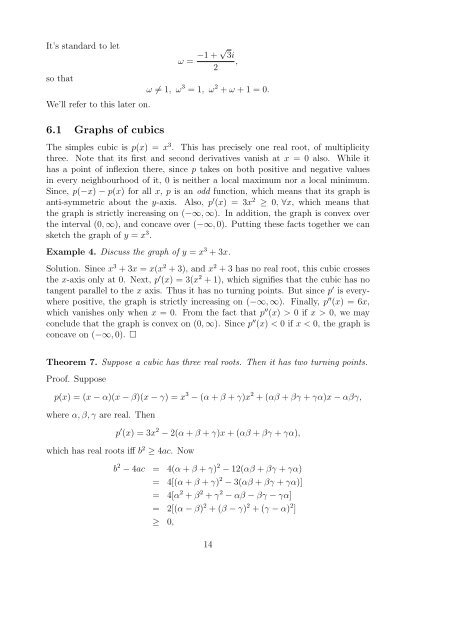Complex numbers and polynomials - University College Cork
Complex numbers and polynomials - University College Cork
Complex numbers and polynomials - University College Cork
Create successful ePaper yourself
Turn your PDF publications into a flip-book with our unique Google optimized e-Paper software.
It’s st<strong>and</strong>ard to letso thatWe’ll refer to this later on.ω = −1 + √ 3i,2ω ≠ 1, ω 3 = 1, ω 2 + ω + 1 = 0.6.1 Graphs of cubicsThe simples cubic is p(x) = x 3 . This has precisely one real root, of multiplicitythree. Note that its first <strong>and</strong> second derivatives vanish at x = 0 also. While ithas a point of inflexion there, since p takes on both positive <strong>and</strong> negative valuesin every neighbourhood of it, 0 is neither a local maximum nor a local minimum.Since, p(−x) − p(x) for all x, p is an odd function, which means that its graph isanti-symmetric about the y-axis. Also, p ′ (x) = 3x 2 ≥ 0, ∀x, which means thatthe graph is strictly increasing on (−∞, ∞). In addition, the graph is convex overthe interval (0, ∞), <strong>and</strong> concave over (−∞, 0). Putting these facts together we cansketch the graph of y = x 3 .Example 4. Discuss the graph of y = x 3 + 3x.Solution. Since x 3 + 3x = x(x 2 + 3), <strong>and</strong> x 2 + 3 has no real root, this cubic crossesthe x-axis only at 0. Next, p ′ (x) = 3(x 2 + 1), which signifies that the cubic has notangent parallel to the x axis. Thus it has no turning points. But since p ′ is everywherepositive, the graph is strictly increasing on (−∞, ∞). Finally, p ′′ (x) = 6x,which vanishes only when x = 0. From the fact that p ′′ (x) > 0 if x > 0, we mayconclude that the graph is convex on (0, ∞). Since p ′′ (x) < 0 if x < 0, the graph isconcave on (−∞, 0). □Theorem 7. Suppose a cubic has three real roots. Then it has two turning points.Proof. Supposep(x) = (x − α)(x − β)(x − γ) = x 3 − (α + β + γ)x 2 + (αβ + βγ + γα)x − αβγ,where α, β, γ are real. Thenp ′ (x) = 3x 2 − 2(α + β + γ)x + (αβ + βγ + γα),which has real roots iff b 2 ≥ 4ac. Nowb 2 − 4ac = 4(α + β + γ) 2 − 12(αβ + βγ + γα)= 4[(α + β + γ) 2 − 3(αβ + βγ + γα)]= 4[α 2 + β 2 + γ 2 − αβ − βγ − γα]= 2[(α − β) 2 + (β − γ) 2 + (γ − α) 2 ]≥ 0,14
















